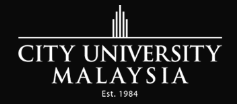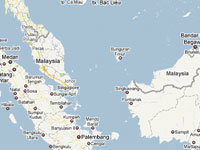Where can I study in Malaysia?
by StudyMalaysia.com on November 19, 2018 | Why Study in Malaysia, Top Stories

The higher education system in Malaysia
Besides an overview of the higher education system in Malaysia, you will be introduced to the types of higher educational institutions in Malaysia and what you need to know before applying to a college or university.
Let’s begin by getting to know the education governing authorities in this country.
Education Governing Authorities
The Malaysian education structure can be divided into pre-tertiary and tertiary education levels. The former is governed by the Ministry of Education (MOE) (or Kementerian Pendidikan Malaysia in Malay) while the latter comes under the Ministry of Higher Education (MOHE).
Previously, education came under only one ministry, namely, MOE. In 2004, MOHE was created to manage the higher education sector which was fast expanding. Subsequently, both ministries were merged in 2013 to facilitate the smooth implementation of the Malaysia Education Blueprint 2013-2025. On 28 July 2015, the government once again reestablished MOHE.
Organisational Structure of the Ministry of Higher Education
The following departments and sectors come under MOHE:
- The Department of Higher Education
- Public Higher Education Management Sector
- Private Higher Education Management Sector
- The Department of Polytechnic and Community College Education
- The Higher Education Management Sector
- The Higher Education Development Sector
- Malaysian Qualifications Agency
- National Higher Education Fund Corporation (PTPTN)
- National Professor Council
- Higher Education Leadership Academy
- Tunku Abdul Rahman Foundation
- All public universities in Malaysia
Education Legislation
The legal regulatory framework that governs the provision of education in Malaysia aiming at ensuring quality education to all, well-managed institutions, include:
- The Education Act 1996
- The Private Higher Education Institutions Act 1996 (Act 555)
- The National Council on Higher Education Institution Act 1996
- The Malaysian Qualifications Agency Act 2007 (replacing the previous Act namely, the National Accreditation Act Board 1996 which has been repealed)
- The Universities and University Colleges (Amendment) Act 2009 (Act A 1342)
- The National Higher Education Fund Corporation Act 1997
- Universiti Teknologi MARA Act 1976 (Act 173)
- The National Higher Education Fund Corporation 1997 (Act 566)
- The Private Higher Educational Institutions (Amendment) Act 2009 (Act A1352)
The Education Act 1996 covers pre-tertiary levels of education under the national education system which comprises preschool, primary, and secondary education as well as post-secondary education. The other eight acts regulate the provision of higher education in Malaysia.
Why is education legislation important?
Legislation in education is important to you as it helps protect your rights as a student. It provides a framework to regulate how HEIs are run. It also assures the quality of education and qualifications you receive (and pay for). Essentially, it protects the rights of students like you.
Academic Qualifications
Malaysia has a well-defined internationally recognised qualification framework. The qualifications awarded by all approved HEIs in Malaysia are governed by the Malaysian Qualifications Framework (MQF). The Malaysian Qualifications Act 2007 provides for the establishment of the Malaysian Qualifications Agency (MQA) whose main role is to implement MQF. MQA is an internationally recognised qualification assurance body, and a member of the ASEAN Quality Assurance Network (AQAN) and other networks; while MQF benchmarks against the standards of the UK, Australia, New Zealand and Europe (Bologna process and EQF).
MQF specifies the minimum number of credits required for each level of programme. That means that students needs to achieve the following minimum number of credits (indicated in brackets) before an academic qualification can be awarded to them by the higher educational institution at which they are studying, e.g. certificate (60 credits), diploma (90 credits), bachelor degree (120 credits), and taught master degree (40 credits). Master and doctoral degrees obtained by research do not have credit values.
The various levels of higher education qualifications based on MQF are as follows:
| Education levels | Higher education qualification | Minimum credit required for the award of qualification |
|---|---|---|
| 8 | Doctoral (by research) | No given credit value |
| 8 | Doctoral Degree (by mixed mode or coursework) | 80 |
| 7 | Master degree (by research) | No given credit value |
| 7 | Master degree (by mixed mode or coursework) | 40 |
| 7 | Postgraduate diploma | 30 |
| 7 | Postgraduate certificate | 20 |
| 6 | Bachelor degree | 120 |
| 6 | Graduate diploma | 60 |
| 6 | Graduate certificate | 30 |
| 5 | Advanced diploma | 40 |
| 4 | Diploma | 90 |
| 3 | Certificate | 60 |
| 1-3 | Skills certificate | According to the skill and levels |
Source: MQA
The Malaysia Education Blueprint 2015-2025 (Higher Education)
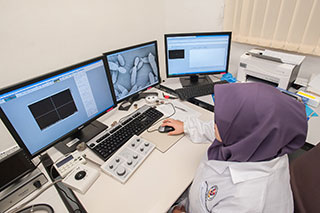 Launched on 7 April 2015, the Ministry of Education developed the Malaysia Education Blueprint 2015-2025 (Higher Education) or the MEB (HE) with the aim of evolving in order to stay abreast of global trends in education. Through its system aspirations and 10 shifts, the outcomes of the Blueprint will benefit all higher education students in Malaysia, both local and international.
Launched on 7 April 2015, the Ministry of Education developed the Malaysia Education Blueprint 2015-2025 (Higher Education) or the MEB (HE) with the aim of evolving in order to stay abreast of global trends in education. Through its system aspirations and 10 shifts, the outcomes of the Blueprint will benefit all higher education students in Malaysia, both local and international.
System Aspirations for Higher Education
The MEB (HE) covers five system aspirations for higher education, that is, to improve:
Access – to increase access to and enrolment in higher education mainly through growth in technical and vocational education and training (TVET), private higher learning institutions (HLIs) and online learning;
Quality – to improve the quality of graduates by increasing the current 75% graduate employability rate to more than 80% in 2025, to improve the quality of institutions with the aim of placing one university in Asia’s Top 25, two in the Global Top 100, and four in the Global Top 200, and to improve the quality of the overall system by raising its U21 ranking for research output from 36th out of 50 countries to the top 25, and to increase the number of international students in HLIs from 108,000 today to 250,000 students in HLIs and schools by 2025;
Equity – to ensure that all Malaysians have the opportunity to fulfill their potential regardless of their background, for example, improving the enrolment rate and completion rate of students from socio-economically disadvantaged backgrounds and communities;
Unity – to ensure that enrolment in HLIs reflects the mix of Malaysia’s ethnicities with the aim of creating an education system that provides students with shared values, shared experiences, and common aspirations by embracing diversity; and
Efficiency - to maximise the return on investment in higher education and to maintain the current levels of government expenditure per student across public institutions; and to rise from 44th out of the 50 countries in the U21 output ranking that covers research, enrolment, and employability to be in the top 25 by 2025.
10 Shifts
To achieve these aspirations as stated in the above, the MEB (HE) outlines 10 Shifts that will spur continued excellence and transformation in the higher education system.
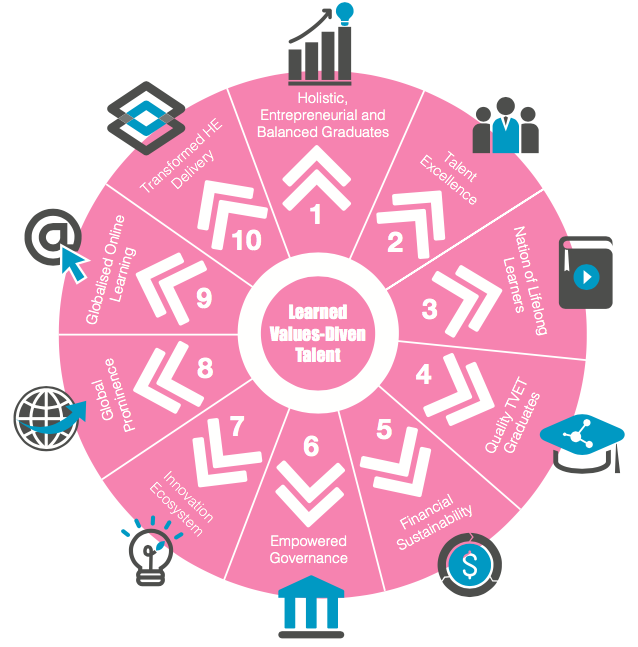
The objectives of each Shift are:
Shift No. 1 - Holistic, Entrepreneurial and Balanced Graduates
To develop holistic, entrepreneurial and balanced graduates in line with the National Education Philosophy who can contribute towards the betterment of the family, society, nation and global community. These qualities are re ected by six primary attributes – ethics, and spirituality, leadership skills, national identity, language pro ciency, thinking skills and knowledge.
Shift No. 2 - Talent Excellence
To develop an academic community that is relevant and respected in both the local and international community by to attracting, developing, and retaining excellent talent both locally and internationally.
Shift No. 3 - Nation of Lifelong Learners
To make learning and relearning an integral part of the Malaysian way of life through a well-coordinated, high quality lifelong learning system; and by establishing learning communities in every organisation.
Shift No. 4 - Quality TVET Graduates
To be a premier higher education TVET provider that develops skilled talent to meet the growing and changing demands of industry, and promotes individual opportunities for career development.
Shift No. 5 - Financial Sustainability
To establish a sustainable nancing system for Malaysia’s higher education that is focused on outcomes and performance that involves:
Continued government investment of a large portion of the national budget in the higher education system for a return on investment that is comparable to that of peer industries
Diverse sources of funding for public and private HLIs to allow continuous improvement in the quality of their programmes, and more prudent and innovative use of their resources; and
More targeted support for socio-economically disadvantaged students to make enrolment more affordable and accessible to everyone who is eligible for higher education
Continued government investment of a large portion of the national budget in the higher education system for a return on investment that is comparable to that of peer industries
Diverse sources of funding for public and private HLIs to allow continuous improvement in the quality of their programmes, and more prudent and innovative use of their resources; and
More targeted support for socio-economically disadvantaged students to make enrolment more affordable and accessible to everyone who is eligible for higher education
Shift No. 6 - Empowered Governance
To develop a portfolio of fully- autonomous and semi-autonomous HLIs that can operate freely within the regulatory framework established by the government.
Shift No. 7 - Innovation Ecosystems
To facilitate the development of innovation ecosystems in a few national priority areas through new collaboration models across academia, industry, government and community, in order to fuel the nation’s economic growth.
Shift No. 8 - Global prominence
To develop Malaysia as an international education that is valued by students for its competitive advantage in providing value for money higher education and that balances quality and affordability with the added value of rich cultural experiences. A target enrolment of 200,)00 international students by 2020 and 250,000 by 2025 is the aim.
Shift No. 9 - Globalised Online Learning
To be a premier education hub through GOL by increasing the of quality education for Malaysians and the global community.
Shift No. 10 - Transformed HE Delivery
To transform the higher education system beginning with the transformation of the Ministry through transparent delivery, with effectiveness and ef ciency levels comparable to that of the private sector. Subsequently, the Ministry seeks to catalyse transformation among private and public HLIs.
All these transformation efforts will benefit local students and international students as well.
| The number of higher educational institutions and student enrolment are: (as at 30 June 2016): |
| 20 public univesities |
| 495 private higher educational institutions |
| 34 polytechnics |
| 94 community colleges |
| 1,253,501 student enrolment (as at 31 Dec 2015) |
| 125,089 international students (undergraduate and postgraduate levels) |
Higher educational institutions in Malaysia
There are two categories of higher education institutions under the jurisdiction of the Ministry of Higher Education (MOHE) Malaysia:
Government-funded public universities, polytechnics, community colleges and public colleges
Private higher educational institutions (i.e. institutions not funded by the government) which include:
non-university status institutions such as private colleges
university status institutions such as university colleges
foreign university branch campuses e.g. Monash University Malaysia and The University of Nottingham Malaysia Campus
Did you know?
Higher education enrolment has increased over the years. Do you know how many students are pursuing higher education in Malaysia in 2016?
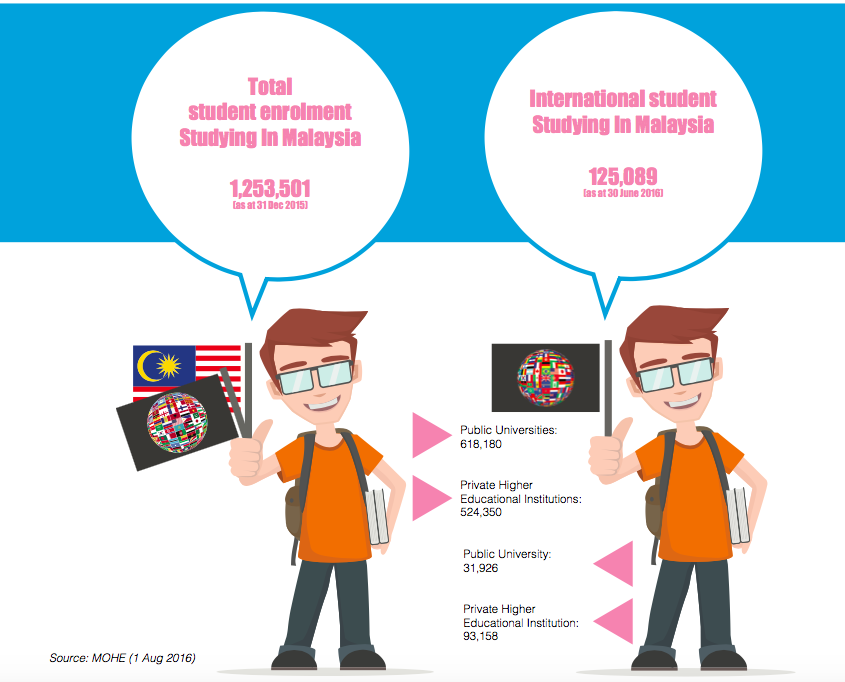
MOHE is directly responsible for the operation and performance of public HEIs, whereas private HEIs are guided by MOHE’s policy guidelines and objectives.
International students coming to study in Malaysia can apply to public universities and private higher educational institutions. Let’s take a closer look at the institutions that fall under these categories:
| Public universities |
|---|
Public universities are fully funded by the government and are governed as self- managed institutions. They offer mainly bachelor degrees and postgraduate programmes, with some offering programmes at diploma level and foundation levels. There are 20 public universities in Malaysia, with at least one in every state. Public universities generally have a larger campus and student enrolment; and offer a wide variety of different elds of study. These universities can be divided into ve research, 11 comprehensive universities and four universities specialised technical universities (MTUN). The ve public universities that have been designated as research universities are Universiti Malaya (UM), Universiti Putra Malaysia (UPM), Universiti Kebangsaan Malaysia (UKM), Universiti Sains Malaysia (USM) and Universiti Teknologi Malaysia (UTM). USM has also been awarded Apex university status.). The four universities under Malayisan Technical University Network (MTUN) are UTHM, UTeM, UMP and UniMAP. The rst public university was established in 1962. Pure science courses (e.g. physics, chemistry, biology, mathematics and statistics) are offered at all public universities but are not commonly offered at private universities. Other specialised courses such as agricultural sciences, forestry, shery, veterinary, agro-based, earth science, marine science, town planning, nanotechnology, aerospace engineering, humanities are available mainly at public universities. |
| Private universities |
|---|
Like public universities, private universities are independent institutions or self-funded institutions that award their own undergraduate and postgraduate degrees and conduct a certain amount of research. Some universities also offer diploma and foundation level programmes. The rst private university was established in year 1997. Popular social science courses offered are psychology, communication and journalism. Engineering, medical degree and ICT degrees of various specialties are also popular programmes sought- after by students. In the eld of business, accountancy and nance, degrees are offered with specialisations of various combinations – management, economics, banking or commerce. Private universities also offer many courses in the eld of allied health sciences. As private universities are self-funded and many run by commercial enterprises, the tuition fees are higher than that of public universities. |
| Private university colleges |
|---|
Similar to private universities, private university colleges in Malaysia have the power to award their own undergraduate degrees and postgraduate quali cations. They are smaller in terms of physical size and student enrolment. Generally, university colleges also have limited faculties and specialise in a given eld or elds. University colleges do not focus much on research-based postgraduate programmes but they offer bachelor degree, diploma and foundation level quali cations. Most of the private university colleges have been upgraded from college status. The tuition fees are similar to that of private universities. |
| Foreign university branch campuses |
|---|
These universities are invited by the Malaysia government to establish their off-shore campus in Malaysia. There are currently nine foreign university branch campuses in Malaysia,. These universities originate from Australia, China and the UK. They award their own degree (undergraduate and postgraduate), diploma and foundation studies quali cations. The quali cations are identical to that of the host universities. The rst private university was established in 1998. Tuition fees are higher than private universities but are lower than at the host universities abroad. |
| Private colleges |
|---|
Colleges in Malaysia are independent institutions that award their own quali cations at diploma and certi cate levels, foundation studies, as well 3+0 foreign university degrees and split degrees Colleges also provide tutorial support for professional and semi- professional body quali cations such as ACCA, ICAEW, CLP, LCCI, CAT, GCE A-Levels, etc. College campuses and their enrolment may be smaller than universities. These institutions have no power to award their own bachelor’s degree quali cation. Some of these institutions have existed as early as the 1960s. Tuition fees are generally lower than that of private universities. |
There are many institutions for international students like you to choose from. To fnd out which one suits you best in terms of your study interests and budget, read the next section on ‘Applying to a college or university – what you need to know’
20 Public Universities in Malaysia
Note: Public universities can be divided into five research universities, 11 comprehensive universities and four specialised technical universities (MTUN). The five public universities that have been designated as research universities are Universiti Malaya (UM), Universiti Putra Malaysia (UPM), Universiti Kebangsaan Malaysia (UKM), Universiti Sains Malaysia (USM) and Universiti Teknologi Malaysia (UTM). USM has also been awarded Apex university status.. The four universities under the Malaysian Technical University Network (MTUN) are UTHM, UTeM, UMP and UniMAP.
Source:
- jpt.moe.gov.my, June 2018
- Education Guide Malaysia (15th edition)
34 Private University Colleges in Malaysia
| No. | Name of university | Date established | Location |
|---|---|---|---|
| 1 | International University College of Technology Twintech (IUCTT) North Borneo University College, Sabah (formerly known as International University College of Technology Twintech, Sabah campus) |
upgraded in 2013 | Sabah |
| 2 | Selangor International Islamic University College (SIUC) | upgraded in 2004 | Selangor |
| 3 | Cyberjaya University College of Medical Sciences (CUCMS) | established in 2005 | Selangor |
| 4 | Kuala Lumpur Metropolitan University College (KLMUC) | upgraded in 2007 | Kuala Lumpur |
| 5 | TATI University College | upgraded in 2007 | Terengganu |
| 6 | Berjaya University College of Hospitality | established in 2007 | Kuala Lumpur |
| 7 | Melaka Islamic University College | upgraded in 2009 | Melaka |
| 8 | Linton University College | upgraded in 2010 | Negeri Sembilan |
9 |
KDU University College | upgraded in 2010 | Selangor |
10 |
Widad University College | upgraded in 2011 | Pahang |
| 11 | KPJ Healthcare University College | upgraded in 2011 | Negeri Sembilan |
| 12 | Lincoln University College | upgraded in 2011 | Selangor |
| 13 | Southern University College | upgraded in 2012 | Johor |
| 14 | Bestari University College | established in 2012 | Terengganu |
| 15 | Vinayaka Mission International University College | established in 2013 | Penang |
| 16 | University College of Technology Sarawak | established in 2013 | Sarawak |
| 17 | Tunku Abdul Rahman University College | upgraded in 2013 | Kuala Lumpur / Penang, Johor, Perak |
| 18 | Islamic University College of Science & Technology | established in 2013 | Kelantan |
| 19 | Geomatika University College | upgraded in in 2013 | Kuala Lumpur |
| 20 | Islamic University College of Perlis (KUIPs) | established in 2014 | Perlis |
| 21 | University College Sabah Foundation (UCSF) | established in 2014 | Sabah |
| 22 | Kolej Universiti Agrosains Malaysia | established in 2014 | Melaka |
| 23 | Kolej Universiti Islam Pahang Sultan Ahmad Shah | established in 2015 | Pahang |
| 24 | Kolej Universiti Poly-Tech MARA | upgraded in 2015 | Kuala Lumpur |
| 25 | KDU University College | upgraded in 2015 | Penang |
| 26 | First City University College | upgraded in 2015 | Selangor |
| 27 | New Era University College | upgraded in 2016 | Selangor |
| 28 | Fairview University College | established in 2017 | Selangor |
| 29 | International University College of Technology Twintech (IUCTT) | upgraded in 2003 | Kuala Lumpur / Kelantan |
| 30 | Saito University College | upgraded in 2017 | Selangor |
| 31 | Han Chiang University College of Communication | upgraded in 2017 | Penang |
| 32 | Genovasi University College | established in 2017 | Selangor |
| 33 | PICOMS International University College | upgraded in 2018 | Kuala Lumpur |
| 34 | University College of Yayasan Pahang | upgraded in 2018 | Pahang |
47 Private Universities in Malaysia
| No. | Name of university | Date established | Location |
|---|---|---|---|
| 1 | Multimedia University (MMU), Cyberjaya | established in 1997 | Cyberjaya / Melaka / Johor |
| 2 | Universiti Tenaga Nasional (UNITEN) | established in 1999 | Putrajaya / Pahang |
| 3 | Universiti Tun Abdul Razak (UniRAZAK) | established in 1999 | Selangor |
| 4 | Universiti Teknologi Petronas (UTP) | established in 1999 | Selangor |
| 5 | International Medical University (IMU) | established in 1999 | Kuala Lumpur |
| 6 | Universiti Selangor (UNISEL) | established in 2000 | Selangor (Shah Alam and Bestari Jaya) |
| 7 | Open University Malaysia (OUM) | established in 2000 | Kuala Lumpur |
| 8 | Malaysia University of Science & Technology (MUST) | established in 2000 | Selangor |
| 9 | AIMST University | established in 2001 | Kedah |
| 10 | Universiti Tunku Abdul Rahman (UTAR) | established in 2002 | Selangor / Perak |
| 11 | Universiti Kuala Lumpur (UniKL) | established in 2001 | 11 campuses located in Kuala Lumpur and around the country |
| 12 | Wawasan Open University | established in 2006 | Penang |
| 13 | Albukhary International University | established in 2006 | Kedah |
| 14 | Al-Madinah International University (MEDIU) | established in 2006 | Selangor |
| 15 | International Centre for Education in Islamic Finance (INCEIF) | established in 2006 | Kuala Lumpur |
| 16 | Limkokwing University of Creative Technology | upgraded to university college in 2003, and further upgraded to full university status in 2007 | Putrajaya |
| 17 | Management and Science University (MSU) | formerly KUTPM which was established in 2001 and upgraded to full university in 2007 | Selangor |
| 18 | Asia e University (AeU) | established in 2007 | Kuala Lumpur |
| 19 | UCSI University | upgraded to university college in 2003 and further upgraded to full university status in 2008 | Kuala Lumpur / Terengganu Sarawak |
| 20 | Quest International University Perak | established in 2009 | Perak |
| 21 | INTI International University (IIU) | upgraded to university college in 2006 and further upgraded to full university status in 2010 | Negeri Sembilan |
| 22 | Taylor’s University | upgraded to university college in 2006 and further upgraded to full university status in 2010 | Selangor |
| 23 | Sunway University | upgraded to university college in 2004 and further upgraded to full university status in 2011 | Selangor |
| 24 | Manipal International University | established in 2010 | Nilai |
| 25 | Perdana University | established in 2011 | Selangor |
| 26 | HELP University | upgraded to university college in 2004 and further upgraded to full university status in 2011 | Kuala Lumpur |
| 27 | UNITAR International University | established in 2011 | Selangor |
| 28 | Raffles University Iskandar (RUI) | established in 2011 | Johor |
| 29 | Malaysia Institute of Supply Chain Innovation (MISI) | established in 2011 | Selangor |
| 30 | Nilai University | upgraded in 2007 and further upgraded to full university status in 2012 | Negeri Sembilan |
| 31 | SEGi University | upgraded in 2008 and further upgraded to full university status in 2012 | Selangor |
| 32 | Asia Pacific University of Technology and Innovation (APU) | upgraded in 2004 and further upgraded to full university status in 2012 | Kuala Lumpur |
| 33 | Binary University of Management and Entrepreneurship | upgraded in 2004 and further upgraded to full university status in 2012 | Selangor |
| 34 | Infrastructure University Kuala Lumpur (IUKL) | upgraded in 2003 and further upgraded to full university status in 2012 | Selangor |
| 35 | Asia Metropolitan University | upgraded in 2008 and further upgraded to full university status in 2012 | Selangor/Johor (Two campuses: Cheras campus, Selangor and Johor) |
| 36 | Putra Business School | established in 2012 | Selangor |
| 37 | Global NXT University | established in 2012 | Kuala Lumpur |
| 38 | MAHSA University | upgraded in 2009 and further upgraded to full university status in 2013 | Selangor |
| 39 | International University of Malaya-Wales | established in 2013 | Kuala Lumpur |
| 40 | University Malaysia of Computer Science and Engineering | established in 2013 | Putrajaya |
| 41 | Universiti Islam Malaysia, Cyberjaya | established in 2014 | Selangor |
| 42 | DRB-HICOM University of Automotive Malaysia | established in 2015 | Pahang |
| 43 | Asia School of Business | established in 2015 | Kuala Lumpur |
| 44 | City University | upgraded in 2010 and further upgraded to full university status in 2016 | Selangor |
| 45 | Meritus University | established in 2016 | Kuala Lumpur |
| 46 | Universiti Sultan Azlan Shan | upgraded in 2012 and further upgraded to full university status in 2016 | Perak |
| 47 | Universiti Islam Antarabangsa Sultan Abdul Halim Mu’adzam Shah | upgraded in 2006 and further upgraded to full university status in 2018 | Kedah |
Source:
- jpt.moe.gov.my, June 2018
- Education Guide Malaysia (15th edition)
10 Foreign University Branch Campuses in Malaysia
| No. | Name of Branch Campus | Location in Malaysia | Country of Origin |
|---|---|---|---|
| 1 | Monash University Malaysia, established in 1998 | Selangor | Australia |
| 2 | Curtin University, Sarawak Malaysia, established in 1999 | Sarawak | Australia |
| 3 | The University of Nottingham Malaysia Campus, established in 2000 | Kuala Lumpur / Selangor | United Kingdom |
| 4 | Swinburne University of Technology, Sarawak Campus, established in 2004 | Sarawak | Australia |
| 5 | Newcastle University Medicine Malaysia, established in 2007 | Johor | United Kingdom |
| 6 | University of Southampton Malaysia Campus, established in 2011 | Johor | United Kingdom |
| 7 | Heriot-Watt University Malaysia, established in 2012 | Putrajaya | United Kingdom |
| 8 | University of Reading Malaysia, established in 2013 | Johor | United Kingdom |
| 9 | Xiamen University Malaysia Campus, established in 2015 | Sepang, Selangor | China |
| 10 | Royal College of Surgeons In Ireland And University College Dublin Malaysia Campus, established in 2018 | Penang | Ireland |
Source:
- jpt.moe.gov.my (Ministry of Higher Education)
- Education Guide Malaysia (14th edition), published by Challenger Concept (StudyMalaysia)
List of private colleges in Malaysia
There are 399 private colleges in Malaysia as at June 2016. Click here for a list of private colleges in Malaysia.
And for a list of courses offered at higher education institutions in Malaysia, please log onto www.studymalaysia.com.
Applying to a college or university
Need help deciding which college or university is best for you? Here’s a handy list of items you need to know and consider before applying to study in a HEI in Malaysia.
-
Course fees
Before you enrol, ensure that the programme meets your budget - don't forget to cost in accommodation, textbooks and other expenditure
-
Accreditation & Recognition
Make sure that the institution is approved my MOHE, the course accredited by MQA, and the qualifications you obtain upon graduation enables you to pursue the career you want
-
Internship
What kind of internship programme does the institution offer?
-
Qualification
Who awards the qualification? Does the qualification allow you to pursue the career you want?
-
Location
Would you prefer to have the live-in experience of a big university campus or the buzz of a campus in a big city?
-
Entry requirements
Every institution has a different set of entry requirements – check them out before applying
-
Facilities
What kind of facilities does the institution offer?
-
International student services
What kind of support does the institution offer to international students?
-
Entertainment & Recreation
Besides going for classes, studying, and working on your assignments, what kind of student life do you picture yourself having? Does the institution offer you the lifestyle you want?
-
Medium of instructionThe majority of undergraduate and postgraduate courses are conducted in English – make sure you meet the English proficiency requirements
-
Curriculum
Check what subjects are offered – two bachelor degrees with the same name can have very different curricula
-
Assessment
What's the assessment method for the programme?
 Source: Study in Malaysia Handbook 10th Ed.
Source: Study in Malaysia Handbook 10th Ed.All rights reserved. No part of this editorial contents may be reproduced, copied, translated, or stored in a retrieval system or transmitted in any form or by any means without the written consent from the publisher Challenger Concept (M) Sdn Bhd (www.studymalaysia.com/challenger)
You May Also Be Interested In...
The cost of higher education in Malaysia
![The cost of higher education in Malaysia - StudyMalaysia.com]() One of the many reasons why international students choose Malaysia is ...
One of the many reasons why international students choose Malaysia is ...�Cost of Studying and Living in Malaysia
![�Cost of Studying and Living in Malaysia - StudyMalaysia.com]() One of many reasons why international students choose Malaysia is beca...
One of many reasons why international students choose Malaysia is beca...Malaysia's Excellent Accomplishments
![Malaysia's Excellent Accomplishments - StudyMalaysia.com]() Malaysia has grown tremendously and has become a more developed countr...
Malaysia has grown tremendously and has become a more developed countr...�Map of Malaysia
![�Map of Malaysia - StudyMalaysia.com]() Malaysia is situated in South-eastern Asia, between 2 and 7 degrees no...
Malaysia is situated in South-eastern Asia, between 2 and 7 degrees no...�Why make Malaysia your destination of choice when studying abroad
![�Why make Malaysia your destination of choice when studying abroad - StudyMalaysia.com]() 12th most preferred education destination in the world among internati...
12th most preferred education destination in the world among internati...Affordable, Quality-Assured Education
![Affordable, Quality-Assured Education - StudyMalaysia.com]() The cost-effective, high quality tertiary education is one of the many...
The cost-effective, high quality tertiary education is one of the many...
















